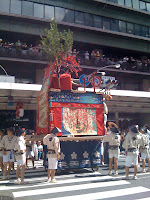Last Saturday, we took a day trip (an hour's bus ride) to a lovely little town, Ohara, on the north side of Kyoto, tucked into the Kitayama Mountains. The chief attraction in Ohara is Sanzen-in, a temple with a famously beautiful garden, filled with images of Buddha and other whimsical statuary. This garden was again filled with moss, everywhere rolling luxuriously. Strolling through it was a lovely way to spend a couple of hours. One of our favorite sights, though, was a group of teenagers, dressed in traditional garb, boys as well as girls, taking in the Ohara temples along with us. It seems that everyone in Japan, kids included, makes a constant effort to retain the old customs and traditions. Unembarrassed, fully into the endeavor.




After Sanzen-in, we took the guidebook's advice and went to two other smaller temples that were very close by. These turned out to be wondrous surprises. In each place, matcha tea and sweets were part of the admission tickets. We were able to sit in lovely tatami-floored rooms and look out at even more lovely, but smaller, gardens. One of them, Hosen-in, purports to have a ceiling made of wood taken from the floor of a castle in which hundred of samurai committed sepuku (suicide) after a humiliating defeat. In the wood ceiling, they say, you can still see the blood stains. It sure did look like it to us. The other small temple, Jikko-in, was erected by the monk, Jakugen, who helped to introduce
shomyo, Buddhist hymns intoned in a single voice or by a chorus of monks (not unlike Gregorian chant), into Japan.

The temple housed a collection of musical instruments including this xylophone-like instrument made of stone. We were allowed to try it out, and the tone, amazingly, was beautiful.

The interior of Jikko-in was exquisite (picture).

Not yet finished with our temple tour, we hiked across Ohara to a remote temple called Jakko-in. It was getting late in the day, and the walk took us initially past some small shrines (I love these little guys lined up in a row)

and finally up through a small farming village, our first up-close authentic glimpse of rural Japan.
There were no signs at all in English and the road wound around and took some unexpected turns. I remember thinking when I first visited Japan twenty years ago that it would be fun to get out of the cities, but how on earth could you do it without a guide? Turns out, it all works out somehow. This was quite remote, and quite twisty, but we did find Jakko-in.


We reached Jakko-in, we found out later, just before it was closing down for the day. We climbed up lots of steps to the small temple and this little garden with its famous (and dead) thousand-year-old Himekomatsu pine tree. This tree is mentioned in ancient texts and was carefully and lovingly preserved. In 2000, it was badly damaged by a fire, and finally succumbed in 2004. Yet it is still preserved as the centerpiece of the garden. The pamphlet piece in English says, "This garden has a quiet, elegant atmosphere that conveys a sense of the pathos of existence . . . ." Hm-m. I was happily snapping pictures of a large Buddha inside the small temple when a monk---clad in flowing orange silk, drop-dead gorgeous, right out of central casting--swooped down on me and said "No pictures!" "I'm sorry," I said and put my Iphone camera away. From then on, every time I looked over my shoulder, the monk was staring at me, sure that I was about to sneak another shot. It actually got weird--I felt like I was being stalked. He then went to the big bell and began to ring it--we got the message and got out. Pathos of existence, indeed!
























































